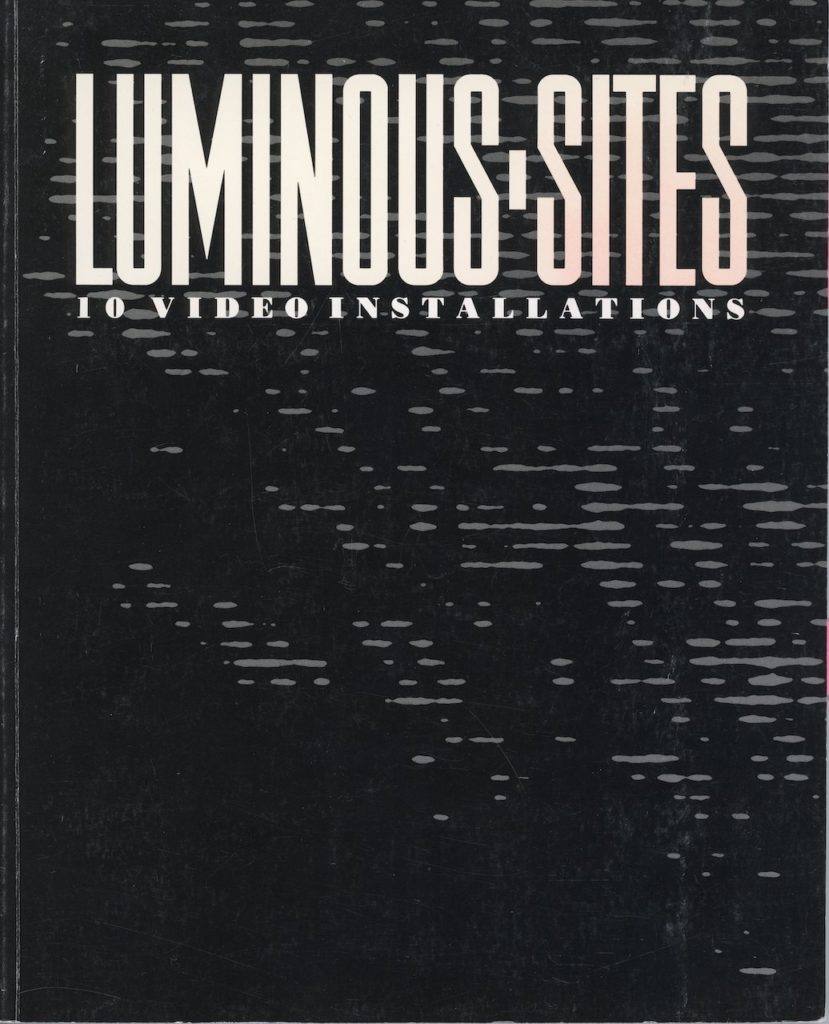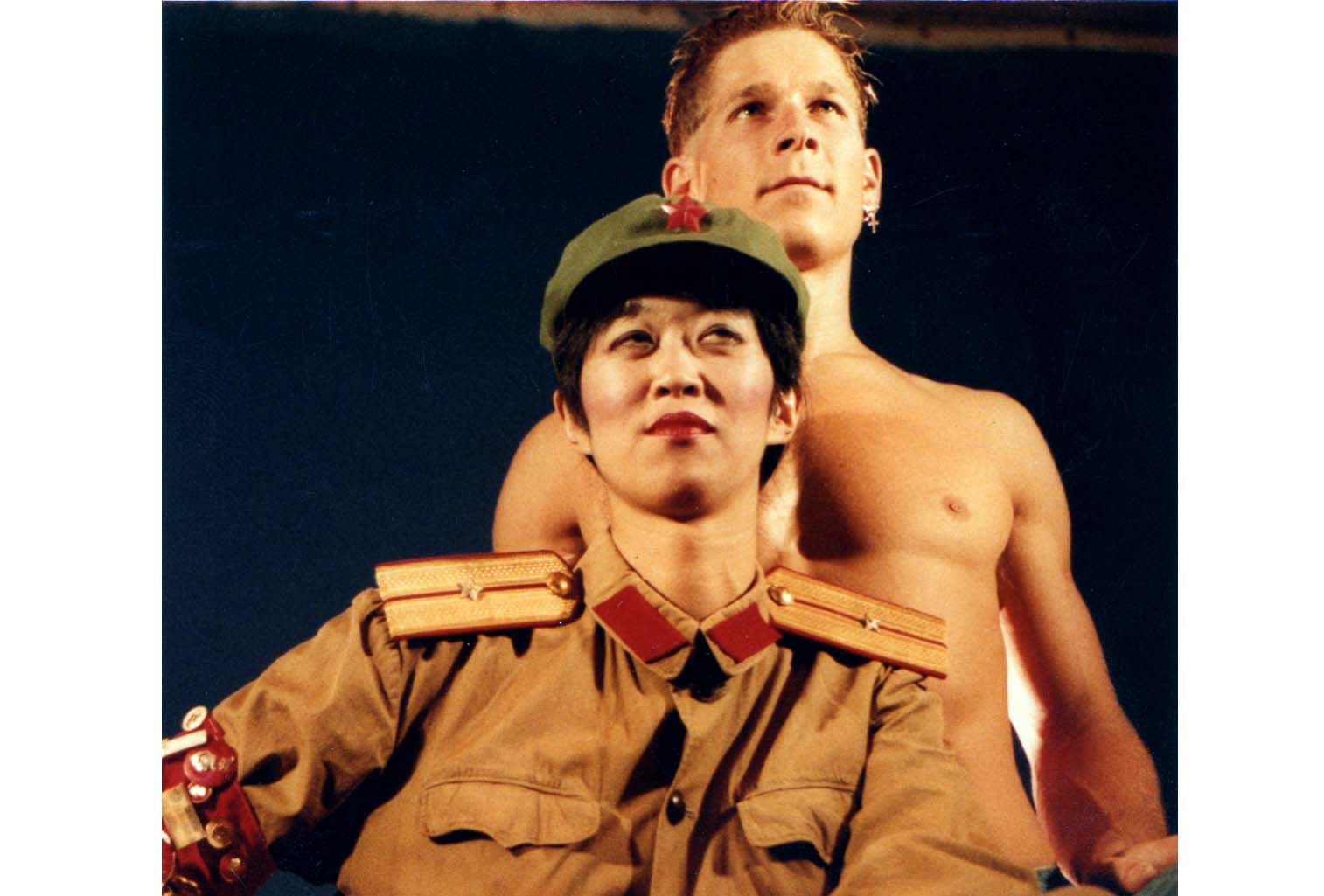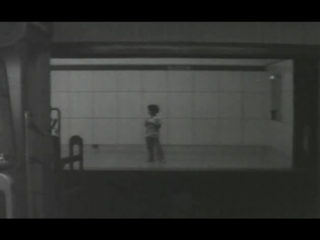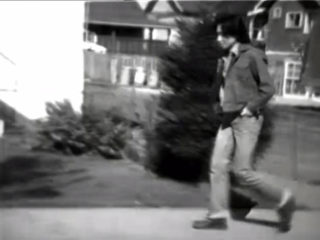BODY FLUID
Paul Wong, 1987
22min video
A skillful, sensual rendering of an intriguing performance orchestrated by the artist. Through a fog-laden atmosphere, iconic figures emerge to perform on a huge turntable. Our look at this garishly lit spectacle is mediated by the gaze of a female Red Guard. All flesh and brilliance, this tape appears to critique popular culture by robbing it of any ostensible content. Hollywood proverb says, beneath the surface of fake tinsel lies only the real tinsel – the detritus of our times.
Body Fluid is an electronic spectacle of live and pre-recorded video projections, live acoustic and recorded quadrophonic music, lighting effects and mechanical devices. It is a revolving display of performers as mass media icons taking part in a structuralist rearrangement of the elements of television.Body Fluid is a site-specific work for the ½ RPM truck turntable in the Sears/Harbour Centre shipping and receiving area.
This video was based the on a performance as part of Luminous Sites (1986) an exhibition of 10 video installations in Vancouver.
Excerpt from Retrieving Culture by Daina Augitis and Karen Henry in Luminous Sites 10 Video Installations (1986) p52-53
In Paul Wong’s ambitious production Body Fluid, the rituals are the hollow gestures of “primetime.”
“In a big underground parking garage centred on an 18.2-metre-wide rotating metal disc travelling at 1/2 revolution per minute, we find three rear-screen projection screens with silhouettes and shadows of images projected from live cameras and prepared tapes. As performers spin on revolving platforms on top of the rotating disc, video light is cast on many different planes, turning it into a ‘calculus of space.’ Technicians with headphones have a serious industrial look. In a pall of smoke, a baton twirler performs to the beat of synthesized music. In a pink dress, a silver-tailed lady throws roses into a great fan; the petals separate and float past her head while a strobe light illuminates her figure on a screen. She is being videotaped. A man with no shirt, standing on one leg, revolves on a disc holding a silver mirror-ball with his muscular arms, sending reflected light into the darkness. He then begins a sensuous dance with a pocket-sized surveillance video camera aimed at himself. He is being videotaped. Images of a revolving planet appear on the screen. A woman in Chinese army fatigues holds aloft a machine gun … “1
We are witness to an opulent array of video technology and lighting effects set in a multi-perspective vision. Body Fluid is about body movement – flowing body motions that ricochet between live action and projections and ultimately flow into a bricolage of images. These images of macho men and attractive women are stereotypically familiar, culled from popular culture. Their presence alludes to, but makes no judgments about, the motifs of talent, glamour, physical strength, beauty, ego. The actors are symbols; even the Chinese woman in the Red Army uniform is romanticized and turned into a powerless cultural icon. But together they create a larger-than life spectacle, an amplification of reality, by fully exploiting the technology that brings these images to us. In allowing all of the technical supports to be visible, the artist makes us aware of the illusion before us. By stripping off the narrative and presenting only the form, he reveals the surface manipulations. The elements of popular culture – music, lights, actors – are all reframed and revealed for what they are, so that as viewers we become aware of our seduction by these perfect, ultra-real images. In his discussion of spectacle, Hal Foster suggests that “we become locked in its logic because spectacle both affects the loss of the real and provides us with the fetishistic images necessary to deny or assuage this loss.” 2 Paul Wong’s fascination with mass culture leads him to take it apart in the process of cultural investigation without surrendering any of its pleasures.
Forward, Luminous Sites 10 Video Installations (1986) p4-5
Although there is a respected video tradition in Vancouver, artists here have had few opportunities to explore video in installation. Vancouver audiences have not previously been presented with the video installation as a milieu, as have Canadian viewers in Montreal (Video 84) and Toronto (Video Culture Canada). In the Luminous Sites exhibition a group of Canadian artists was offered the opportunity to present works in Vancouver and to provide a context that would involve a broad public and have a significant impact on viewers. We invited artists who have worked primarily in video or in installation to explore the convergence of these two forms and elaborate on the presence of video within installation. Our intent was to introduce Vancouver audiences to the potential of video installations so that a critical dialogue could emerge.
We sought to explore video as an active, many-faceted principle in the sculptural environment. Video emanates into space as a light and energy field, a source of movement and image that both enlivens and seduces, reaching beyond the boundaries of the singular relationship of viewer-to-screen into a dynamic field of interaction with the other elements of the installation. The exhibition encompassed the use of video for its super-realist qualities, as a literal and narrative element, as an interactive and immediate recording device, and for its critical relationship to culture, as a reflection of television and its modes of representation. These are the properties of video that interacted in the Luminous Sites as a whole, according to the distinct priorities of each work. Rather than limit the exhibition to a theme, we allowed each installation to emerge as a separate and specific expression of the concerns of the artist and the possibilities of the site and the medium. Ten artists produced installations in nine different sites that ranged from an underground parking lot to a vacant thirty-first floor of an office tower. Most of the works were in small contemporary galleries which often lack the budgets to exhibit work that incorporates costly video equipment. Indeed, one of the rationales for the exhibition was that the high economic demands of creating and exhibiting “techno-art” negatively influence its rate of accession as a new visual language.

Luminous Sites 10 Video Installations, Catalogue Cover
The use of video in installation is not merely a formalist gesture devoid of content. Aspects of the medium may be explored formally, but its references are unavoidable. The politics of the medium are an inherent part of its use. In its image and mechanisms, video is replete with references to the communication of visual culture and television as a cultural icon. It has been nurtured on the fringe of the arts, as a mongrel with relatives in high art, popular culture and social documentary. Sometimes these close cousins threaten to subsume the movement. In her essay in this catalogue, Peggy Gale first establishes the place of video in installation and then casts a warning glance at the tendency of popular culture to reduce creativity to the level of entertainment, cautioning our need for discretion and critical values. Jody Berland describes the advantages of video’s lack of conformity with either fine art or television, defining its unique character and accessibility as the creative edge in establishing new relations of production and power. In installation, video as a language of culture and a social/political tool enters into a dialogue with the abstract principles of the medium as an aesthetic tool. It serves to bring the issues and potential of video more squarely into the public arena and into the process of art making as a relevant cultural exchange. Video represents a movement toward electronic media and away from static form, into changing time/space relationships, and action and interaction with the community. These latter were the concerns of the avant-garde which attempted to break out of the established mold and make art relevant to a broader cultural experience, as indicated by the early actions and the development of installations which Merike Talve describes in her essay. She states that the spectre of the avant-garde overlooks the critical impetus and its confrontation with context. Th~ installation, based as it is on a three-dimensional site with concrete and abstract references, has the potential to
manipulate symbolic elements into new terms of analysis and meaning. The works in Luminous Sites have multiple references and stand in the tradition of looking at culture from within its experience.
ACKNOWLEDGEMENTS
As co-curators, we shared every aspect of conceiving and producing this exhibition in a rewarding association that was enriched by the many people who supported and encouraged the project. Luminous Sites was sponsored by two artist-run centres in Vancouver, the Video Inn and the Western Front. We wish to thank everyone in these organizations for tolerating a mammoth in their midst, and for getting involved and assisting. A special thank-you is extended to Glenn Lewis for his constant support and guidance. The exhibition could not have been accomplished without the good-natured, capable staff who devoted their time to it; in particular, Alexandra Gray, Michael Brodie, Helga Pakasaar and Stan Douglas. Many people were tangential to the project as staff and volunteers at the nine sites around Vancouver; their good will and hard work were crucial to the success of the project. Luminous Sites was made possible by the financial contributions of the Canada Council and the Department of Communications, and other members of the public and private sector. We remain grateful for all of the support.
Daina Augaitis
Karen Henry
Vancouver, 1986





